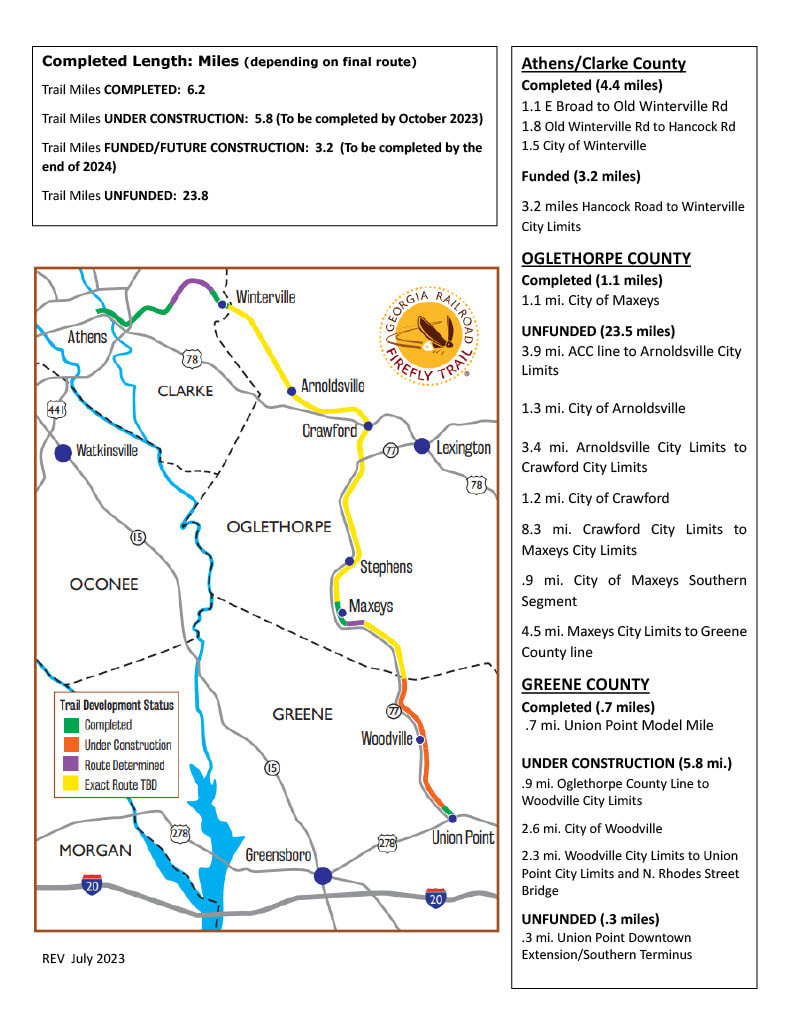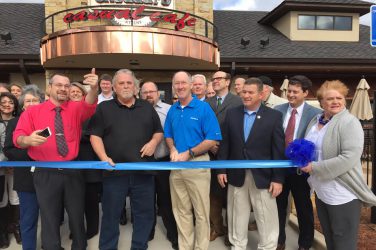Over 200 Athens-area cyclists participated in the Firefly Trail Ticket to Ride event to increase awareness on the importance of improving access to trail and green spaces. The 14th annual bike ride raised nearly $34,000 for the trail’s expansion, emphasizing efforts to connect residents.
“The trail is breathing new life into communities,” said Mary Cook, in her second year as the Firefly Trail, Inc. president.
Electric Bike Group Athens saw several of its members shining in neon green and ready to ride on March 22. The group “[promotes] cycling among people of color” and “[builds] camaraderie among all cyclists,” according to their website.
“Some people enjoy the scenery; some people do it for the exercise,” Damon Allen, the group’s president, said. “Definitely safer than being on the streets.”
Why It’s Newsworthy: Access to parks, trails and green spaces is linked to positive health effects — physical and mental — and Athens’ Firefly Trail is just one example of a growing push to increase access to these vital spaces.
Connecting Communities
The Firefly Trail is a multi-use, 12-mile rail-trail, popular for runners, cyclists and walkers. The first section of the trail opened in 2017 off East Broad Street, funded by local sales taxes and federal grants.
Trail construction costs will total about $24 million, according to a 2016 economic impact study.
The task now is connecting trail segments together. Planned to stretch a total 39 miles in length, the path will connect Athens-Clarke, Oglethorpe and Greene counties.

“Amazingly, it brings the communities together,” said Mark Ralston, the board’s past president, highlighting the people of Winterville and Union Point. “That’s how they think of it and that’s how they care for it — it’s theirs and they are proud of it.”
Cook agrees. She hopes the trail will connect nearby communities when construction wraps.
The communities [are] where the trails are,” she says. “People are getting out on the trail and meeting their neighbors that they never met before.”
Value of Being Outside
“We don’t need any more industry that would cause noise or pollution or dust,” Cook said. “We need something to celebrate the beautiful environment.”
This green movement in Athens reflects actions that cities around the world are taking to prioritize cleaner living. Paris residents recently approved a referendum to turn 500 streets into pedestrian areas and remove car access. In Barcelona, the city is transforming over 26,000 square meters of roads into public space for pedestrians.

Athens, Georgia, is following their lead. College Square, directly across from UGA’s campus, closed to car traffic in 2020 to accommodate safe outdoor seating. The Athens Downtown Development Authority is planning to expand that pedestrian area, adding more trees and outdoor seating.
But changes like these are typically accompanied by higher rent prices for nearby housing and a displacement of residents: green gentrification.
Researchers from Georgia State University uncovered the phenomenon around Atlanta’s Beltline, 22 miles of trail space bordered by apartments, restaurants and retail space. The process of “restoring degraded urban areas by adding green features” increased the price of housing, displacing working-class residents. It also displaced Black residents.
Cook is committed, though, to the Firefly Trail not having that same effect. She knows “property values increase when a trail comes in,” and hopes a moratorium on property tax in East Athens, she said, could help with that effort.
“Our thought all along was to engage the people in East Athens with the trail for exercise and alternate transportation” without seeing the harmful effects of gentrification, Cook said.
The trail will “[bring] in tourist dollars, especially once we get these sections connections,” she said.
She’s, arguably, not wrong. A 2016 analysis by Georgia Tech estimates the Firefly Trail’s annual economic impact at $14.7 million when fully completed.
“When a rail-trail comes up, the towns revitalize,” she said.

Green Space Access Reflects Broader Inequalities
Access to trails, parks and green spaces is vital, Ralston said. Not just for someone’s physical and mental health — also for tightening communities’ bonds.
But access to these spaces is limited for some. Researchers at the University of British Columbia discover that access to parks and green spaces “reflect broader class and racial divides.”
Education level and income are key factors, for instance, because wealthier individuals can afford homes close to green space. Race is another factor. The study found that Latino and Black residents had a negative correlation associated with green space access, whereas white individuals had greater access.
“Residents with higher levels of education and higher incomes were more likely to have more access to both mixed and woody urban vegetation,” the paper reads. “Racialized residents were less likely to have access to mixed and woody vegetation in large, dense urban areas.”
A similar study found the average park size in predominantly Black neighborhoods in New York City was 7.9 acres.
In predominantly white neighborhoods? 29.8 acres — almost four times the size.
Access to trails and green spaces is also an issue of healthcare. Greenspace exposure is linked to a variety of health benefits, “including decreases in diastolic blood pressure, salivary cortisol, heart rate and incidences of diabetes.”
While health benefits are a top priority, at its core, the Firefly Trail is about building community.
“That’s what we’re just the proudest of: sharing it with everybody,” Cook said.

Christian Conte is a senior majoring in journalism and political science.









Show Comments (0)